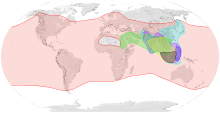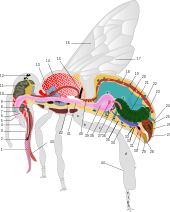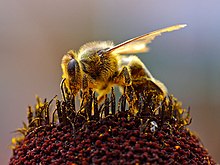Honey bee
![]()
This article is about the honeybee genus; for the most common species, see Western honeybee and Eastern honeybee.
Honey bees (Apis) are a genus of the true bee family (Apidae). Depending on the taxonomic view, the genus comprises seven to twelve state-forming species, most of which are native only to Asia.
For the world-wide beekeeping the western honey bee has the biggest meaning; in many Asian countries also the eastern honey bee originally occurring there is held in simple block hives or cavities of walls. These two species breed in the protection of caves and were thus able to spread very far out of the tropical regions into more temperate climatic zones, as a result of which regionally different subspecies have developed, especially in the case of the Western honey bee. A natural border of colonization is often formed by mountains or islands.
In addition, there are the wild species with free-hanging nests that are used on a modest scale for honey production, especially the giant honeybee and the dwarf honeybee - this is known as honey hunting.

Distribution map Apis andreniformis Apis cerana Apis dorsata Apis florea Apis koshevnikovi Apis nigrocincta Apis mellifera

Anatomy of a honey bee worker

Honey bee collecting pollen
Features
The genus includes small to moderately large species, with body lengths between 7 and 19 millimeters. They are relatively elongated in outline and moderately densely hairy, including the also hairy compound eyes. In workers, the mandibles bear neither teeth nor keels. As in queens, their claws are divided, with an arolium between them as an adhesive pad on smooth surfaces. The tibiae of the hind legs do not bear spurs, they are, like the first tarsal limb, expanded in females as a collecting device for pollen and form a basket (corbicula) (basket collector). Typical for the genus is especially one feature of the wing vein. The radial cell of the forewing is very elongate, about four times as long as its distance from the tip of the wing, its apex rounded. The wing-mark (pterostigma) is narrow and inconspicuous. The genitalia of males (called drones) are weakly sclerotized and simplified in structure, greatly enlarged is the endophallus located inside the aedeagus.
Fossil honeybees
Fossils attributed to the genus Apis are available from the Oligocene and Miocene of Europe, Asia and, surprisingly, North America, and thus outside the recent natural range of the genus. Some of the best finds are from the Randecker Maar fossil deposit. Numerous species have been described, mostly based on details of wing veining, including Apis henshawi Cockerell and Apis armbrusteri Zeuner, some of which closely resemble the recent Apis cerana and Apis mellifera in morphology. A possible explanation would be that at least in Europe only one species of the genus lived at a time, but it was morphologically quite variable. The fossil species of the genus are very similar to the recent species, so that it can be assumed that the genus remained morphologically almost unchanged over many millions of years.
Questions and Answers
Q: What is a honey bee?
A: A honey bee is any bee that belongs to the genus Apis. They are eusocial flying insects which live in colonies and produce and store honey.
Q: How many known species of bees are there?
A: There are 20,000 known species of bees.
Q: How many species of true honey bees exist?
A: There are seven species of true honey bees, with a total of 44 subspecies.
Q: What is the study of honey bees called?
A: The study of honey bees is known as melittology.
Q: When did Apis bees first appear in the European fossil record?
A: Apis bees first appeared in the European fossil record at the Eocene–Oligocene boundary (34 million years ago).
Q: Are there any Apis species native to the New World before Europeans introduced them?
A: No, there were no Apis species native to the New World before Europeans introduced them. The only fossil species found was a single 14-million-year-old specimen from Nevada.
Q: How do honeybees communicate with each other?
A: Honeybees communicate with each other using scent produced by Nasonov's gland which produces a pheromone used to get worker bees together or draw lost ones back to the hive.
Search within the encyclopedia